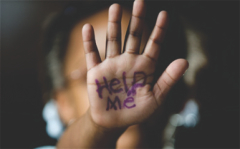 Onslaught of cases prompts advocate to share tips for
recognizing, reporting abuse
Onslaught of cases prompts advocate to share tips for
recognizing, reporting abuse
The news reports are as shocking as they are relentless:
An Army sergeant in Maryland charged with 1st-degree child abuse, accused of starving, beating and burning her 4-year-old stepdaughter.
A North Carolina Child Protective Services supervisor and her husband, a nurse, arrested after their 11-year-old foster son is found handcuffed to a porch railing with a dead chicken tied around his neck.
Three malnourished sisters in Arizona, ages 12, 13 and 17, kept locked in their bedrooms for up to two years. Neighbors reported they sometimes heard children’s voices at the house at night, but never saw anyone during the day.
“These are just a few of the most recent stories you’ll find about child abuse around the country,” says Rayne Golay, a mental health counselor, children’s advocate, and award-winning author of a newly published novel, The Wooden Chair, (http://www.raynegolay.com/), which she hopes will prompt witnesses to speak up about suspected abuse and neglect.
“These cases remind us that child abusers can look like upstanding members of society. They can be your very nice neighbor, a trusted professional, the guy at the grocery store.”
In the case of the Army sergeant, Golay notes that an observant schoolteacher spoke up about her concerns, which led to the arrest of the child’s stepmother. The three sisters in Arizona, however, were not discovered until the two youngest girls escaped after their stepfather kicked in their bedroom door and threatened them with a knife.
“Neighbors said they’d heard children at night, but never saw them,” Golay says. “Wouldn’t you call that suspicious?”
She offers these suggestions for recognizing and reporting suspected child abuse.
• Don’t be afraid to be wrong. You don’t need to have hard evidence or proof of child abuse or neglect to report your concerns. If you’re wrong, social workers and investigators will soon discover that and close the case. It might be uncomfortable for the alleged abuser and he or she may get angry. But you can report anonymously, and it’s far better to risk someone taking offense or social workers finding no evidence of abuse than for a child to suffer because no one speaks up.
• Actions often speak volumes. Does a young child cringe, raise an arm defensively or try to hide when her mother turns to her? These behaviors can be the reflexive response of a child who’s frequently hit. Do you know a child who has become withdrawn, had a persistent loss of appetite, or started doing poorly in school? Changes in behavior may signal a variety of emotional problems, including abuse and neglect. What about witnessing an adult lose their patience with a child at a store or other public place in a manner that seems over-the-top? If it appears to be an emergency, call 911, Golay says. Otherwise, try to defuse the situation. “You might smile at the parent and say something like, ‘It can be so hard to bring kids shopping. I remember it well.’ Scolding or criticizing will only make the situation worse, but attention and understanding words may calm the person.”
• How to report your concerns? If you want to talk to a professional crisis counselor before making a report, call Childhelp National Child Abuse Hotline, 1-800-4-A-CHILD (1-800-422-4453). While counselors cannot file a report for you, they can answer your questions, provide information about resources, and discuss the situation that has drawn your concern. The hotline is staffed 24 hours a day, 7 days a week. To report abuse, each state has a toll-free number; find the list at tinyurl.com/ReportChildAbuse. If you witness a situation that requires an immediate law enforcement response, call 911.
“Whatever you do,” says Golay, “do something.”
“We’re all very aware of child abuse and neglect, but still, most people continue to hang back and say or do nothing when they have concerns,” she says. “This is not acceptable. We all have a duty to keep our children safe.”

